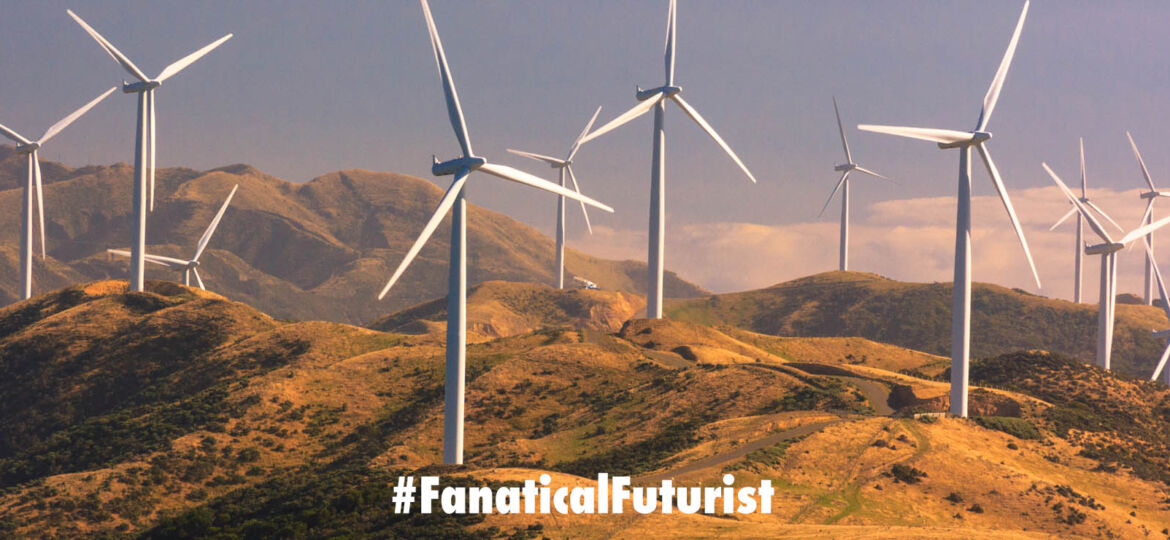
WHY THIS MATTERS IN BRIEF
There are lots of reasons why bigger wind turbines are better, but as they get bigger soon the blades could be supersonic …
 Love the Exponential Future? Join our XPotential Community, future proof yourself with courses from XPotential University, read about exponential tech and trends, connect, watch a keynote, or browse my blog.
Love the Exponential Future? Join our XPotential Community, future proof yourself with courses from XPotential University, read about exponential tech and trends, connect, watch a keynote, or browse my blog.
You might of heard of wind turbines that are forty stories tall, and giant, but as the world’s thirst for energy accelerates extreme engineering is becoming the norm as offshore wind continues to scale up. Sweeping the area of 12.3 standard NFL fields each rotation, with gargantuan 140 meter (459 ft) blades, the new giant busting Chinese MySE 18.X-28X wind turbine will be the largest wind turbine ever built. By a country mile …
Only a week ago, I heard about CSSC’s new H260-18MW, the world’s largest wind turbine. Partially constructed at a special and very spacious seaside facility, this offshore wind giant took over from MingYang’s MySE 16.0-242 as the biggest wind turbine on the planet.
Now, MingYang has struck back in this game of one-up manship with the announcement of something significantly bigger. And it’s not like CSSC’s 18-megawatt rated effort was small; each of its three blades stretches a near-unthinkable 128 m (420 ft). But the new MySE 18.X-28X promises to push “beyond the 18 MW threshold,” with a mind-boggling swept area of 66,052 sq m (711,000 sq ft).
The Future of Energy 2050, by Futurist Matthew Griffin
MingYang says it’ll handle “the most extreme ocean conditions,” including level-17 typhoons with wind speeds over 56.1 m/s (202 km/h / 125.5 mph). Given an average wind speed of 8.5 m/s (30.6 km/h / 19 mph), MingYang projects it will produce 80 GWh of energy per year,” sufficient to supply 96,000 residents.”
But why go to the trouble of making these things so enormous in the first place? Well, increasing the swept area of your wind turbine increases the slice of sky you’re harvesting energy from, and it bumps up your overall yield while dramatically reducing the cost per MwH generated – which is quickly nearing zero. But perhaps more importantly, wind farms need to be thought of as total systems. One of the biggest costs in an offshore installation is the work needed at the sea bed to root these huge turbines down and give the wind something to push against.
So both MingYang and CSSC sell these mammoth mega-turbines primarily as cost-cutting measures that’ll help bring down the capital cost of wind farm setup, and eventually the cost of the energy they produce.
“Compared to the installation of 13MW models,” reads a statement by MingYang on LinkedIn, “the higher output of the MySE18.X-28X would save 18 units required for a 1GW wind farm, shaving off construction costs by $120,000 – 150,000 per Megawatt.”
Using my advanced math skills, I have deduced this would represent a CAPEX saving of $120-150 million on a gigawatt-scale project. For reference, the 1.2-GW Hornsea One Project, built using 7-MW turbines, is estimated to have cost “at least £4.2 billion” or $5.153 Billion, so while $150 million can’t be considered chump change, it might represent a couple of percent on a project this big.
One does have to wonder how big these things will get before manufacturers find a practical upper limit to offshore wind turbine size. Will it be the point at which the blade tips go supersonic I wonder? Will it be limited by how big the factory spaces will need to get, or the logistics of trucking and towing these goliaths out into deep water bit by bit – something that’s already causing GE to 3D print wind turbine bases in situ – and winching their massive blades up to bolt onto their hubs? Will they last as long as smaller turbines, given the outsized loads they have to bear? Will they prove cheaper over the long haul, given that a single unit failure will take out a larger proportion of a site’s capacity.
Either way, as a fan of extreme engineering I have to marvel at these towering green-energy giants. They’ll truly be a sight to see, reaching somewhere around a thousand feet up from the water. Somebody better set up a GoFundMe for Don Quixote; the man’s going to need a dolphin and a humdinger of a lance.
















